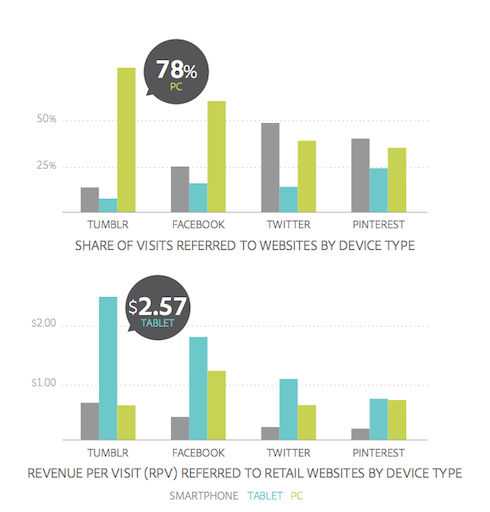By Liam Dowd - September 9th, 2014
This week's top stories and findings in easy to digest chunks
Social retail is mobile
As you read this Apple will have unveiled its latest iPhone. For corporations trying to leverage their e-commerce presence in an increasingly mobile environment, paying close attention to mobile consumer behaviour is vital.
According to the latest 2014 Mobile Benchmark Report, Adobe has concluded that over a third (36%) of referral visits from social media services to e-commerce site come from mobile devices.
- 64% of Pinterest’s referred traffic comes from mobile browsers, ahead of Facebook.
- 62% of Twitter referrals are from tablets and smartphones.
- 36% of all social referred visits to retailers come from a tablet or smartphone.
- Tumblr referrals produce highest revenue per visit (RPV) from mobile devices.
- Bounce rates for referrals from social networks are higher on mobile devices than desktops (61% vs. 53%).
“The mobile landscape is constantly evolving and mobile needs to be front and centre of any digital marketing strategy to keep up with technology innovations and consumer expectations,” said John Mellor, vice president of strategy and business development, Adobe Marketing Cloud. “Major brands face tremendous competition in the battle for reaching mobile consumers. 2015 will be a game changing year for marketers who must deliver highly personalised content across screens.”
In tweet purchasing
Twitter has been beavering away on a mechanism to monetise its platform. Your corporation may have already seen, or have participated in Twitter’s testing of a buy button embedded on tweets.
“This is an early step in our building functionality into Twitter to make shopping from mobile devices convenient and easy, hopefully even fun,” said Twitter in its recent announcement. “Users will get access to offers and merchandise they can’t get anywhere else and can act on them right in the Twitter apps for Android and iOS; sellers will gain a new way to turn the direct relationship they build with their followers into sales. We’re not building this alone: we’ve partnered with Fancy (@fancy), Gumroad (@gumroad), Musictoday (@Musictoday) and Stripe (@stripe) as platforms for this initial test, with more partners to follow soon.
“In our test, an entire purchase can be completed in just a few taps. After tapping the “Buy” button, you will get additional product details and be prompted to enter your shipping and payment information. Once that’s entered and confirmed, your order information is sent to the merchant for delivery.”
There is clear traction within this space to make mobile purchasing as easy as possible. Consumers want to make purchases with a tweet. With m-commerce about to outstrip the performance that e-commerce enjoyed, all corporations need to have Twitter commerce on their development roadmaps.
TV twitter
Corporations have long seen the link that TV has with social media activity. New research from Strategy Analytics offers more detailed insights into consumer behaviour. The era of the multi screen TV experience is well and truly here. The traditional coach potatoe viewer are still with us, but increasingly the use of mobile devices is offering viewers an engagement channel they are increasingly using to connect with other viewers.
“Couch Chatterers, who like TV more than average but are particularly prone to chatting with friends about what’s on TV using voice or texting,” said the report’s author David Mercer. “Apart from this Couch Chatterers don’t engage in any “emerging” activities like social networking related to TV shows or watching TV online. They account for 12% of the audience.
“The remaining groups are all multiscreeners, but our analysis indicates that there are three distinct types. Moderate Multiscreeners, accounting for 11% of the total, engage in most online TV and social media behaviours around TV to a reasonable degree, with one notable exception: they do not follow TV shows using Twitter.
“Indifferent Multiscreeners also account for 11% of the total and are the group which is least interested in television overall; for example, they are most likely to go 24 hours without watching TV, and they are least concerned about missing shows. But when they do watch, they engage with and around the content using social media, voice communications and texting. They are also highly likely to follow TV shows using Twitter, and more likely to use smartphones, tablets and PCs to watch TV content.”
TV and social media should be close bedfellow, and this close association is growing but has a long way to go yet. Consumers still use TV as a discrete content consumption channel, with social media activity a separate activity. However, this research shows that TV is increasingly being consumed on mobile devices making the use of more social media inevitable.
Global social media stats
All corporations need to understand how the current social media space is structured and how this is changing. With masses of stats to choose from, We Are Social have done a great job of collating the latest research into a handy presentation, all marketers can make great use of.
Until next time….
The Useful Social Media team.
Next Reads
September 2014, San Francisco
Use social to get closer to your customer. The Corporate Social Media Summit is your one-stop-shop for all the latest social media insight and best practice.
Brochure Programme
